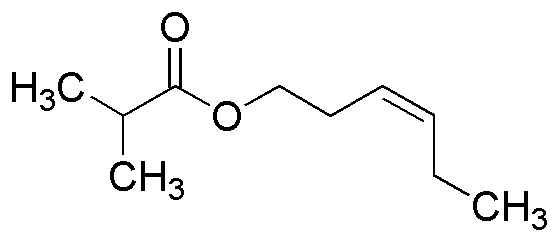cis-3-Hexenyl isobutyrate is widely utilized in research focused on:
- Flavor and Fragrance Industry: This compound is commonly used as a flavoring agent in food products and as a fragrance in cosmetics. Its fresh, green apple aroma enhances the sensory experience of various consumer goods.
- Aromatherapy: Due to its pleasant scent, it is often incorporated into essential oils and diffusers, promoting relaxation and well-being. This application is particularly popular in wellness and spa industries.
- Perfume Formulation: The compound serves as a key ingredient in creating unique perfume blends, providing a fresh and fruity note that can elevate the overall fragrance profile.
- Research in Plant Biology: It is utilized in studies examining plant volatile compounds, helping researchers understand plant communication and responses to environmental stressors.
- Food Preservation: The compound's antimicrobial properties make it a candidate for natural food preservatives, offering a safer alternative to synthetic preservatives while maintaining flavor integrity.
General Information
Properties
Safety and Regulations
Applications
cis-3-Hexenyl isobutyrate is widely utilized in research focused on:
- Flavor and Fragrance Industry: This compound is commonly used as a flavoring agent in food products and as a fragrance in cosmetics. Its fresh, green apple aroma enhances the sensory experience of various consumer goods.
- Aromatherapy: Due to its pleasant scent, it is often incorporated into essential oils and diffusers, promoting relaxation and well-being. This application is particularly popular in wellness and spa industries.
- Perfume Formulation: The compound serves as a key ingredient in creating unique perfume blends, providing a fresh and fruity note that can elevate the overall fragrance profile.
- Research in Plant Biology: It is utilized in studies examining plant volatile compounds, helping researchers understand plant communication and responses to environmental stressors.
- Food Preservation: The compound's antimicrobial properties make it a candidate for natural food preservatives, offering a safer alternative to synthetic preservatives while maintaining flavor integrity.
Documents
Safety Data Sheets (SDS)
The SDS provides comprehensive safety information on handling, storage, and disposal of the product.
Product Specification (PS)
The PS provides a comprehensive breakdown of the product’s properties, including chemical composition, physical state, purity, and storage requirements. It also details acceptable quality ranges and the product's intended applications.
Certificates of Analysis (COA)
Search for Certificates of Analysis (COA) by entering the products Lot Number. Lot and Batch Numbers can be found on a product’s label following the words ‘Lot’ or ‘Batch’.
*Catalog Number
*Lot Number
Certificates Of Origin (COO)
This COO confirms the country where the product was manufactured, and also details the materials and components used in it and whether it is derived from natural, synthetic, or other specific sources. This certificate may be required for customs, trade, and regulatory compliance.
*Catalog Number
*Lot Number
Safety Data Sheets (SDS)
The SDS provides comprehensive safety information on handling, storage, and disposal of the product.
DownloadProduct Specification (PS)
The PS provides a comprehensive breakdown of the product’s properties, including chemical composition, physical state, purity, and storage requirements. It also details acceptable quality ranges and the product's intended applications.
DownloadCertificates of Analysis (COA)
Search for Certificates of Analysis (COA) by entering the products Lot Number. Lot and Batch Numbers can be found on a product’s label following the words ‘Lot’ or ‘Batch’.
*Catalog Number
*Lot Number
Certificates Of Origin (COO)
This COO confirms the country where the product was manufactured, and also details the materials and components used in it and whether it is derived from natural, synthetic, or other specific sources. This certificate may be required for customs, trade, and regulatory compliance.

